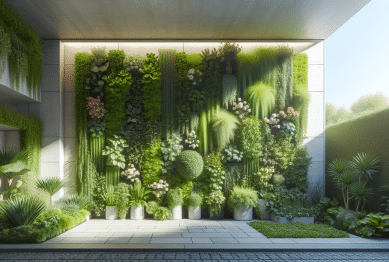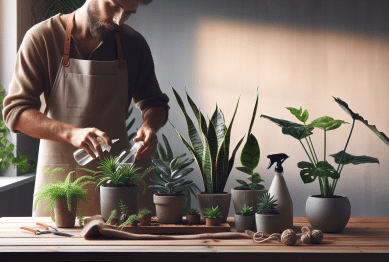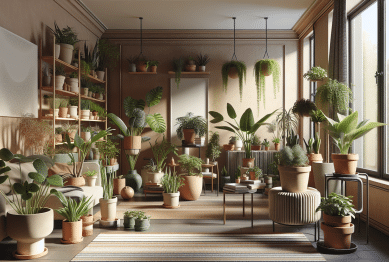Discover how you can make any small garden feel larger and more welcoming with clever design elements, smart planting, and creative upcycling. Whether you have a balcony, tiny yard, or city courtyard, this guide reveals techniques for maximizing garden space without the need for major renovations.
The Art of Creating Illusions in Small Gardens
Many homeowners dream of a lush, spacious outdoor retreat, but often, they are faced with a compact plot or balcony. Luckily, techniques for transforming small garden spaces can create the illusion of more room. Use vertical gardens, trellises, and tall planters to draw the eye upward and make even the narrowest yards feel more expansive. Mirrors are another effective visual trick: when strategically placed, they reflect greenery and light, multiplying the perceived size of your garden. Introducing winding stepping stones or paths also manipulates perspective and encourages exploration, making the area seem larger and more layered. These subtle illusions are accessible for most budgets and require only simple supplies that can be found at home or local stores.
Climbing plants are powerful allies. They make use of vertical space by covering walls, fences, or screens. This allows more room for ground-level features like herb boxes or container gardens, which are especially useful in limited areas. Choose fast-growing vines, such as jasmine or clematis, and combine them with support structures for screening and privacy. Such greenery not only saves space but also increases the overall lushness of the garden. By layering plant heights, you build visual interest from the ground up, ensuring the small space stays inviting and never feels crowded.
In small gardens, every design detail counts. Select light-colored paving materials or mulch, as these tend to reflect light and help open up the area visually. Water features, even as small as a tabletop fountain, can draw attention to different corners, making the space feel dynamic. Maximize sunlight by keeping central pathways clear and trimming overhanging branches. When designing with space-saving principles, your compact garden can transform into a tranquil oasis that feels much larger than its dimensions suggest.
Container Gardening: Versatility for Limited Yards
Container gardening is a key strategy for small garden transformation. It offers unmatched flexibility and is perfect for renters or those with hard landscaping. Containers allow you to shift focal points, experiment with plant groupings, and move flowers or vegetables to highlight different seasons. With the right soil and drainage, even delicate varieties can thrive in pots. Opt for lightweight materials to make rearrangement easier, and choose bold colors or patterns to add personality to the environment. Herb gardens, dwarf fruit trees, and ornamental grasses are all suitable for growing in bowls, troughs, or recycled buckets.
There is creativity in upcycling. Old barrels, watering cans, or even kitchen bowls become unique planters that add charm as well as eco-friendliness. Staggering containers at different heights, such as on pallets or plant ladders, helps you fit more greenery in and builds depth. Hanging baskets provide another solution for vertical planting, leaving precious ground space free for dining furniture or decorative features. Thriving container gardens inspire seasonal refreshes—change out spring bulbs with summer blooms or hearty autumn foliage for constant renewal.
Maintenance is simplified with container setups. You can group plants with similar watering needs together, preventing overwatering or dehydration. This makes garden care more efficient, which is especially important for busy lifestyles or urban dwellers. For edible plants, containers protect your harvests from some pests and soil-borne issues. When chosen carefully, container gardens bring both beauty and practicality to modest outdoor areas without the need for permanent landscaping changes.
Maximizing Light and Color in Compact Spaces
Light management can completely shift the feel of a small garden. Using reflective surfaces—such as glass, white stones, or pale wooden tiles—enhances available sunlight. Carefully placed mirrors tucked behind plants double the visual greenery, making foliage look thicker and richer. Color also plays a big part in expanding a space. Pale, cool hues like soft blues, silvers, and pastel greens visually recede, pushing garden boundaries outward, while bold pops of red or orange in containers draw the eye and add lively energy. Consider alternating foliage textures to maintain interest without cluttering the space.
Lighting design transforms usability. Solar path lights, string bulbs, or subtle step lighting make outdoor areas inviting past sunset, encouraging longer hours outdoors. At night, small spaces with thoughtful lighting can feel magical and cozy rather than confining. Illuminating focal features or plant groupings also adds a touch of drama without overwhelming the limited area. Rain gardens or reflective water bowls can catch and scatter light, offering subtle movement and cooling effects on hot afternoons.
Don’t underestimate the power of flowers and foliage. Select long-season bloomers or plants with variegated leaves to ensure color even outside peak spring or summer. Vertical flower towers and stacked planters take advantage of minimal space while bringing layers of color. With the right brightness and shade management, even the smallest urban plot can appear vibrant, fresh, and much larger than reality suggests—perfect for relaxation or entertaining guests.
Creating Multi-Functional Outdoor Living Areas
Small gardens can work harder when zones are defined for multiple activities. With built-in seating, fold-away tables, or storage benches, functional outdoor areas emerge even in tight spaces. Choose dual-purpose furnishings—think benches that lift for tool storage or side tables that serve as plant stands. By caringly arranging these elements, a garden becomes a room for dining, reading, or container planting. Use screening plants or lattice to carve out private nooks, adding comfort without walls.
Flexible layouts are helpful for dynamic households. Folding chairs, modular containers, and removable pergolas enable a space to shift from quiet retreat to vibrant gathering area with ease. Lightweight outdoor rugs or mats can define conversation areas. Even in a compact yard, these strategies foster socializing, relaxation, and gardening—sometimes, all at once. The versatility appeals to families and singles alike, especially where every square foot is valuable.
Incorporate nature for stress reduction. Research suggests that time outdoors, even in small gardens, greatly improves mood and well-being. Add edible plants among ornamentals for a kitchen-to-table feel. Hang bird feeders or install insect hotels to encourage pollinator visits and wildlife activity—even the tiniest concrete courtyard benefits from a touch of nature. By combining multi-use furnishings and natural elements, a compact space can provide all the rewards of a full-sized garden.
Low-Maintenance Landscaping for Busy Lifestyles
Low-maintenance garden designs are increasingly popular for modern homeowners. Landscape fabrics, gravel mulch, and drought-tolerant plants minimize chores, allowing you to enjoy the garden rather than constantly tending it. Drip irrigation systems or soaker hoses provide consistent watering with less waste and effort. Synthetic turf offers a turf-like look without the upkeep—ideal for families or pet owners seeking year-round greenery. Choose native plants adapted to the local environment for hardiness and ease of care.
Keep it simple by grouping compatible plants together. Arranging perennial grasses, succulents, or evergreens reduces the need for replacements and seasonal replanting. Self-watering containers, slow-release fertilizers, and mulching conserve water and prevent weed growth. These choices combine convenience with sustainability, supporting a healthy outdoor environment. For those with limited mobility or who travel often, raised beds or elevated pots make maintenance more accessible and efficient.
Modern design trends have improved aesthetics for easy-care yards. Clean lines, geometric paving, and minimalist plantings create a calm, uncluttered effect, making the most of smaller areas. Smart garden tools—like automated mowers or app-controlled lighting—help streamline care routines further. With the right planning and materials, it’s possible to achieve an attractive, low‐effort garden that fits any schedule or ability—leaving more time to savor the view.
Sustainable Solutions and Eco-Friendly Garden Ideas
Sustainability is a major driver of small garden design. Collecting rainwater in barrels, composting kitchen waste, and planting for pollinators are simple ways to boost eco-credentials. Choose recycled materials or local stone for edging, paths, or containers. Swapping lawns for wildflower patches or ground covers saves resources and adds biodiversity. Solar-powered garden lights reduce electricity use while illuminating outdoor spaces beautifully at dusk.
Grow food alongside flowers. Herbs and vegetables do well in window boxes or raised beds, providing fresh produce and reducing food miles. Vertical edible gardens are perfectly suited to walls or fences, maximizing crop yield per square meter. Incorporate nitrogen-fixing species like clover or peas among ornamental beds to restore soil health naturally, supporting vibrant plant growth season after season.
Eco-conscious gardening encourages local wildlife and contributes to neighborhood greening. Native shrubs and perennials support beneficial insects, birds, and pollinators. For pest control, companion planting and biological methods reduce reliance on chemicals, preserving healthy ecosystems. Even small changes—like planting a miniature meadow or building a bug hotel—demonstrate how compact gardens can have a positive environmental impact while remaining beautiful and engaging places to spend time.
References
1. Royal Horticultural Society. (n.d.). Small Gardens: Design Ideas & Techniques. Retrieved from https://www.rhs.org.uk/garden-inspiration/small-gardens
2. University of Illinois Extension. (n.d.). Container Gardening. Retrieved from https://web.extension.illinois.edu/containergardening/
3. The Wildlife Trusts. (n.d.). Gardening for Wildlife. Retrieved from https://www.wildlifetrusts.org/gardening
4. Missouri Botanical Garden. (n.d.). Low Maintenance Gardening Tips. Retrieved from https://www.missouribotanicalgarden.org/gardens-gardening/your-garden/help-for-the-home-gardener/advice-tips-resources/gardening-help-faqs/low-maintenance-gardening
5. U.S. Environmental Protection Agency (EPA). (n.d.). Green Landscaping: Greenacres. Retrieved from https://www.epa.gov/greenacres
6. North Carolina State University Extension. (n.d.). Sustainable Gardening. Retrieved from https://gardening.ces.ncsu.edu/sustainable-gardening/









